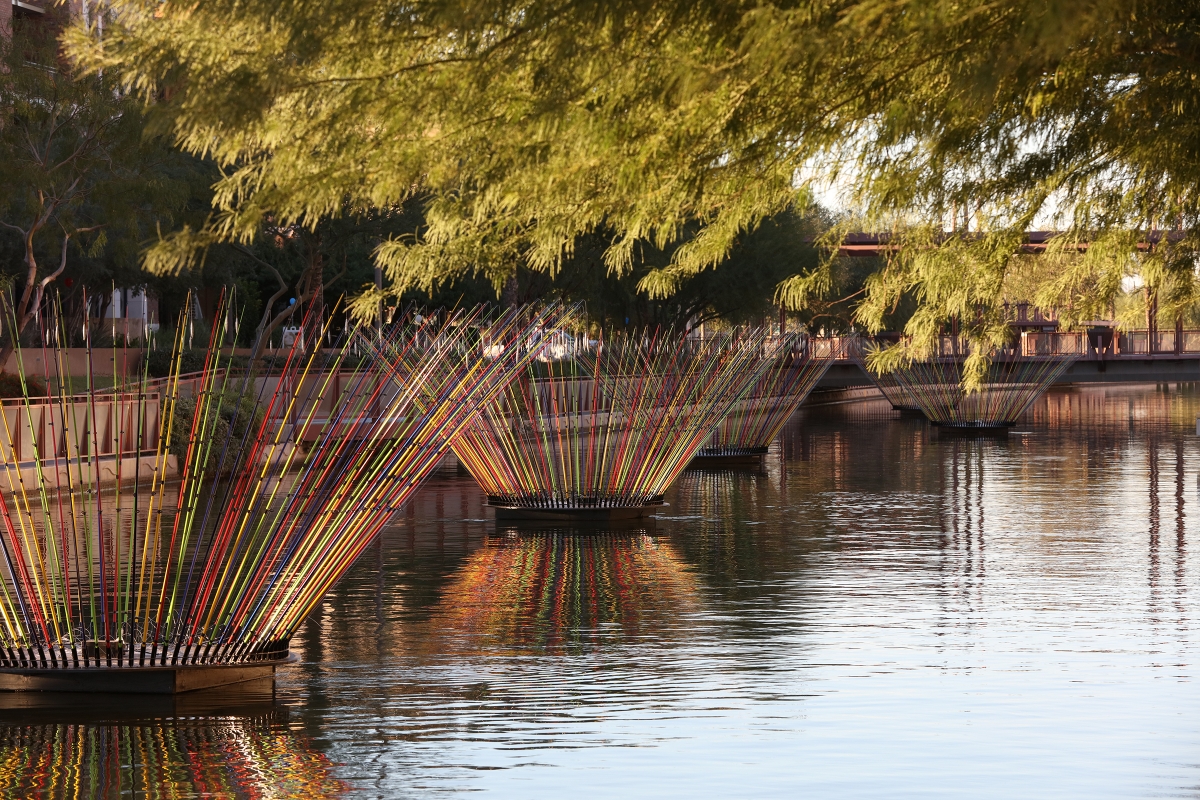Public Art Blooms in the Arizona Canal
Posted by Aug 14, 2017

Donna Isaac
This post is part of our Public Art Network 2017 Year in Review blog salon.
Blooms captivated an artist’s imagination and a city’s connection with its canal system. Bruce Munro brought to life in his first public art installation the playful whimsy of the idea of fishing in the Arizona Canal. Not only is the canal part of a 131-mile system that meanders through the Valley and touches all the cities around Phoenix, Arizona, but it has been the sustaining life force for the Valley as well. Munro’s work plays off the idea that there is, indeed, fishing in the canals. But more importantly, there is also the idea of no fishing. Salt River Project (SRP), which oversees the Valley’s canal system with the federal Bureau of Reclamation, specifically imports the Asian carp or White Amur fish as effective bottom feeders to keep the canal water clean. These fish may be caught, but must be released, which is the concept of “catch and release.”
Respectful of and intrigued by the history of the prehistoric, indigenous people who farmed using a canal system that brought water to the desert landscape, Munro brought to life floating pontoons of fishing rods that sparkled by day in the Arizona sunshine and lit up at night like chandeliers floating atop the canal waters.
Munro was captivated by the idea of fishing/no fishing and endeavored to show this concept with his first public art installation for Scottsdale Public Art. The result, Blooms, was a stunning acknowledgment of the natural environment.
The artist took nearly 18 months to refine his concept. As an artist whose work addresses both the natural elements of a site as well as its history, Munro was intrigued by the history of the Arizona Canal and indeed the entire canal system. Respectful of and intrigued by the history of the prehistoric, indigenous people who farmed using a canal system that brought water to the desert landscape, Munro brought to life floating pontoons of fishing rods that sparkled by day in the Arizona sunshine and lit up at night like chandeliers floating atop the canal waters.
Scottsdale Public Art commissioned Bruce Munro for a five-month installation that was installed November 2015 to March 2016. It was one of the longest temporary installations the program has undertaken and was a featured installation for Canal Convergence 2016 Water + Art + Light. The public art installation was also part of a larger Munro collaborative that took place throughout Scottsdale and Phoenix as Desert Radiance. The Scottsdale Museum of Contemporary Art, the Desert Botanical Garden, and Lisa Sette Gallery all participated with site specific, unique installations.

The installation was comprised of seven floating pods, each one 22 feet in diameter. Each floating “bloom” held one hundred colored fishing rods. There was significant engineering involved to keep the pods floating in a canal that has a substantial current. They also had to be tethered to the sides of the canal bank and to the bottom in a way that would not capture the considerable debris which moves with the water through the canal system. Debris can get caught in any tethering system, and would begin to weight the floating piece down into the water. Blooms withstood the Arizona weather that included considerable winds, dust storms, and some monsoon rains. They not only survived over the five months of the installation intact, but they were as captivating to viewers on the final day of their installation as they were on their first.
Scottsdale Public Art was very proud to have commissioned Blooms and to have brought an international artist of global repute to the Scottsdale Waterfront. Recognition of Bruce Munro’s public art installation—as both a work of beautiful aesthetics and engineering—has been considerable, and we are very proud that it has been recognized by the Public Art Network’s Year in Review as one of 49 projects nationally.





